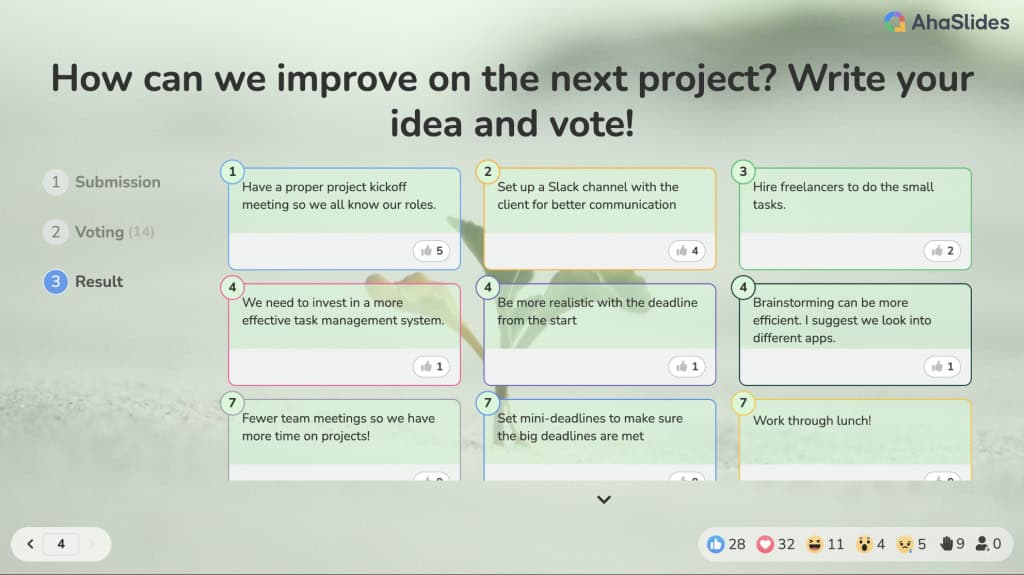Uke waqeda iphrojekthi unomuzwa wokuthi okuthile bekungaba ngcono? Noma mhlawumbe uyiphihlizile wayikhipha epaki, kodwa awukwazi ukubeka umunwe wakho kuyo kungani? Kulapho ama-retrospectives wephrojekthi ngena. Zifana nengxoxo yeqembu lakho, ithuba lokubungaza ukuwina, funda ekuxabaneni, futhi ubeke inkundla yempumelelo enkulu nakakhulu esikhathini esizayo.
Iyini i-Project Retrospective?
I-retrospective yephrojekthi, ngezinye izikhathi ebizwa ngokuthi umhlangano we-retrospective, iseshini ye-retrospective, noma nje i-retro, isikhathi esinikelwe sokuba ithimba lakho lizindle ngephrojekthi ngemva kokuqedwa kwayo (noma ezinqubweni ezibalulekile). Ukubheka emuva okuhlelekile kuwo wonke umjikelezo wempilo wephrojekthi - okuhle, okubi, kanye "nokungaba ngcono."
Cabanga ngalokhu: cabanga ukuthi iphrojekthi yakho iwuhambo lomgwaqo. I-retrospective yithuba lakho lokuqoqana eduze kwemephu ngemva kwalokho, ulandelele umzila wakho, ugqamise ukubukela okumangalisayo (lokho kunqoba okumangalisayo!), thola imigwaqo enezihibe (lezo zinselele eziwusizi), futhi uhlele imizila eshelelayo yohambo oluzayo.
Indlela Yokugijima I-Retrospective Ngokuphumelelayo
Kulungile, asisike i-fluff bese sigxumela phakathi ungawuqhuba kanjani umhlangano obuyela emuva lokho empeleni kuletha imiphumela. Nali uhlaka olulula:
Isinyathelo 1: Setha Isiteji bese Uqoqa Impendulo
I-ajenda. Wonke umhlangano, ubuyela emuva noma cha udinga i-ajenda. Ngaphandle kwayo, besiyoba inyamazane ekukhanyeni, singazi ukuthi kufanele sigxume kuphi. Chaza ngokucacile incazelo nezinjongo zomhlangano obheke emuva. Dala indawo ephephile nevulekile lapho wonke umuntu ezizwa ekhululekile ukwabelana ngemicabango yakhe. Kunamafomethi athile adumile okubuyisela emuva ongayilandela, njengalawa:
Isiqalo - Misa - Qhubeka:
📈 Qala "Yini okufanele siqale ukuyenza?"
- Imibono emisha kuwufanele ukuzama
- Izinqubo ezingekho esizidingayo
- Amathuba okuthuthukisa
- Izindlela ezintsha okufanele zicatshangelwe
🛑 Misa "Kumele siyeke ukwenzani?"
- Imikhuba engasebenzi kahle
- Imisebenzi emosha isikhathi
- Imikhuba evimbela ukukhiqiza
- Izinto ezisibambezelayo
✅ Qhubeka "Yini esebenza kahle okumele siqhubeke siyenza?"
- Imikhuba ephumelelayo
- Ukugeleza komsebenzi okusebenzayo
- Ukuziphatha okuhle kweqembu
- Izinto eziletha imiphumela
Ihambe Kahle - Ukuze Kuthuthukiswe - Izinto Zesenzo:
✨ Uhambe Kahle "Yini esenze saziqhenya?"
- Izimpumelelo ezinkulu
- Izindlela eziphumelelayo
- Iqembu liyawina
- Imiphumela emihle
- Ukusebenzisana okuphumelelayo
🎯 Ukuze Uthuthuke "Singenza kangcono kuphi?"
- Amaphuzu obuhlungu okufanele abhekiswe kuwo
- Amathuba aphuthelwe
- Ukucubungula izingqinamba
- Izikhala zokuxhumana
- Izinselele zensiza
⚡ Izinto zesenzo "Iziphi izinyathelo esizozithatha?"
- Imisebenzi ecacile, engenziwa
- Imithwalo yemfanelo eyabelwe
- Izibopho zomugqa wesikhathi
- Imigomo elinganisekayo
- Izinhlelo zokulandelela
Thola wonke umuntu okhuluma ngokuvota okungaziwa kwe-AhaSlides, amafu egama, i-Q&A ebukhoma nokuvota kwesikhathi sangempela
▶️ Nansi inkomba esheshayo yokuqala: Bhalisela i-AhaSlides, khetha isifanekiso se-retro, usenze ngokwezifiso zakho futhi wabelane ngaso nethimba lakho. Kulula-peasy!

Isinyathelo sesi-2: Hlaziya, Bhekisisa futhi Ukhiqize Imibono Engenzeka
Uma impendulo isiqoqiwe, yisikhathi sokukhomba amatimu abalulekile namaphethini kumpendulo. Kwakuyini ukunqoba okukhulu? Zaziyini izinselele ezinkulu? Zahamba kabi kuphi? Hlanganisa izindikimba ezifanayo ndawonye ukuze uguqule okubonwayo kube izenzo ezibambekayo. Isonge ngesenzo:
- Votela ezintweni ezibalulekile
- Yabela imithwalo yemfanelo
- Setha imigqa yesikhathi
- Hlela ukulandela
Kufanele Ubambe Nini I-Project Retrospective?
Isikhathi sibalulekile! Nakuba i-retro yephrojekthi ivame ukubanjwa ngemva kokuphothulwa kwephrojekthi, ungazikhawuli. Cabangela lezi zimo:
- Ukuphela kwesigaba sephrojekthi: Ukuziphatha ukuphathwa kwephrojekthi okulandela emuva amaseshini ekupheleni kwezigaba ezinkulu ukuze alungise ngokushesha.
- Izikhawu ezivamile: Kumaphrojekthi wesikhathi eside, hlela njalo amaseshini we-retro, njengamasonto onke, kabili ngeviki, nyanga zonke noma ngekota, ukuze kugcinwe umfutho futhi kulungiswe izinkinga ngokushesha. Lokhu kufaneleka ikakhulukazi emaqenjini angewona umkhiqizo njengeminyango yezokuMaketha kanye ne-CS.
- Ngemuva kwesigameko esibucayi: Uma iphrojekthi ihlangabezana nenselele enkulu noma ukuhlehla, a umhlangano we-retrospect ingasiza ukuqonda imbangela futhi ivimbele ukuphindeka.
Yiziphi Izinjongo Eziyinhloko Zokubamba I-Retrospective?
Ama-retrospectives ekuphathweni kwephrojekthi kubalulekile ekuthuthukisweni okuqhubekayo. Banikeza ngendawo ephephile yempendulo ethembekile, amaqembu asizayo:
- Thola ukuthi yini esebenze kahle nengasebenzi. Lona umnyombo wanoma iyiphi iphrojekthi ye-retrospective. Ngokuhlaziya impumelelo nokwehluleka, amaqembu athola imininingwane ebalulekile yamaphrojekthi azayo.
- Yembula izivimbamgwaqo ezifihliwe. Ngezinye izikhathi, izinkinga zibilisa ngaphansi kobuso. Iqembu le-retro kuveza lokhu, okuvumela ukuxazulula izinkinga ngokushesha.
- Khulisa isimilo nokubambisana kweqembu. Ukugubha ukuwina nokwazisa amagalelo awo wonke umuntu kukhuthaza isimo seqembu esihle.
- Shayela ukufunda nokuthuthuka okuqhubekayo. I-Retros ikhuthaza ukukhula kwengqondo, lapho ukufunda emaphutheni kubonakala njengendlela yokuthuthukisa.
- Thuthukisa ukuhlela nokusebenza kwesikhathi esizayo. Ngokuhlaziya ukusebenza kwangaphambilini, amaqembu angakwazi ukwenza ngcono izinqubo zawo futhi asethe okulindelwe okungokoqobo kumaphrojekthi wesikhathi esizayo.
Khumbula, umgomo awukona ukugxila emaphutheni, kodwa ukufunda kuwo. Iseshini ekhiqizayo yokuphatha iphrojekthi lapho wonke umuntu ezizwa ezwiwa, ehlonishwa, futhi egqugquzelekile izofaka isandla kusiko lokufunda nokukhula okuqhubekayo.
Imibono ye-Great Project Retrospective
I-retro yomdabu kwesinye isikhathi ingazizwa isidala futhi ingakhiqizi. Kepha nge-AhaSlides, ungakwazi:
1. Thola wonke umuntu ukuthi avule isifuba
- Ukuvota okungaziwa ukuze uthole impendulo eqotho
- I-Word clouds yokuhlanganisa ingqondo
- I-Q&A ebukhoma enikeza wonke umuntu izwi
- Ukuvota kwesikhathi sangempela ukuze kubekwe phambili izinkinga
2. Kwenze kube mnandi
- Imibuzo esheshayo yokubuyekeza iziqophamlando zephrojekthi: "Masikhumbule izinyathelo zethu ezibalulekile!"
- Inhlolovo ye-icebreaker yokuvusa yonke ingqondo: "Nge-emoji eyodwa, uzizwa kanjani ngephrojekthi?"
- Amabhodi okuhlanganisa imiqondo ahlanganyelwe ukuze uthole imibono yeqembu
- Ukusabela okubukhoma kwempendulo esheshayo
3. Landela intuthuko kalula
- Ukuqoqwa kwedatha ebonakalayo
- Imiphumela ethekelisayo
- Izifinyezo ezilula ukwabelana









